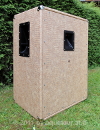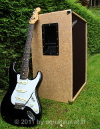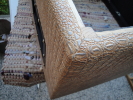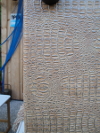| 112
Detuned Guitar Cabinet an oversized 112 cabinet with the detuned approach last update: May 15, 2011 Copyright 2011-25 by H. Gragger. All Rights Reserved. All information provided herein is destined for educational and D.I.Y. purposes only. Commercial re-sale, distribution or usage of artwork without explicit written permission of the author is strictly prohibited.The original units with their associated trade-names are subject to the copyright of the individual copyright owner. The Author is by no means affiliated with any of those companies. References to trade names are made for educational purposes only.By reading the information provided here you agree to the Terms of Use. The working language is kept in English as an aid. Read here why. |
| MAIN PAGE>MUSIC
STUFF>DETUNED_CABINET Index   Gallery Gallery  The Detuned Idea The Detuned Idea   The Making Of The Making Of  Gallery     Back To Index The Detuned Idea This is my
rendering of a
1x12" detuned cabinet (a.k.a. 112). The design
goes back to a
suggestion of Kevin O´Connor from londonpower.com
in Canada. It is
80x60x40cm in size. You can guess its size by
comparing it to the
guitar on its side. On the front grille you can
see the port slots
shining through. The detail picture really shows
the beautiful
alligator tolex pattern and the logo. Hmm. Reminds
me of something...
The enclosure is made from 3/4 inch baltic birch with additional crossbracing. I used battens, heavy glue and screws. The cover is heavy quality tolex crocodile style from Thiele-Box in Germany. The owner is very helpful and friendly and gives you tips for tolexing over the phone. It is glued with Ponal Express (white glue) and Pattex Transparent on the corners. The corner protectors are Fender style. Grille is oxblood. Hardware has been obtained from Thomann. Connectors are one Speak-On type and one standard guitar plug. The term "detuned" has been created by Londonpower to distinguish the design from conventional "tuned" cabinets, i.e. mostly closed cabinets with carefully ports to enhance the bottom range. Basically it is an oversized cabinet that would otherwise take 2x12" speakers with one speaker omitted. The effect is similar to the more common "open back" designs most combo guitar amps have, except that the latter is heavily dependent on proper room placement and the detuned cabinet is not. The detuned approach has several advantages such as its "big" acoustical appearance and extended bottom range. It also has disadvantages, some of which can be counteracted and some not. One disadvantage is weight, one size. There is nothing that can be done about that, but this enclosure is not for the timid. The speaker alone weighs nearly 10 kg. Another disadvantage (although common to all big cabinets) is increased beaming (higher frequencies are concentrated to a small beam in front). This can be partially compensated by using a disperser (acoustical lens). I used slots that also protect the speaker from mechanical damage. I used an Eminence Delta Pro-12, a real powerhouse P.A. speaker with 400 W(RMS) rating. This does not expose the usual mid hump many guitar speakers have, because in times of speaker emulation devices a "neutral" speaker is advised. Nevertheless, it sounds excellent for guitar and even blues harp. A powerful speaker like that may appear oversized. Is it? You can easily blow out a 100W Speaker with a meagre 20W amp running on its limits. Why? A distorting amplifier delivers near square-wave signals into a speaker, meaning the speaker gets flooded with enormous HF content. You won´t hear that, but the speaker has to burn this energy. Also, an undersized speaker is always running close to its limits, far from being linear. If you like that, go on. Being capable of sheer power does not mean you have to run this enclosure at those levels. It also delivers a beautiful crisp tone that I did not manage to achieve with any of the gear I had before. This speaker is said to be a work-a-like of the much more expensive Electro-Voice EVM-12L classic, which can of course be installed without modification due to their physical similarity. Sound is incredibly big and very beefy for all styles. Due to its large dimensions the bass range is comparably extended and the sound is rather "brown" - which mates well with a pretty trebly Fender head. Unfortunately, recording an enclosure´s tone and playing it back on some unpredictable sound system is futile, so no sound samples are planned on this site. Back To Index The Making Of For
years I have been tinkering with tube amps. Like
many others, I read
all the books that are there. One of the authors I
profited most from
is Kevin O´Connor from Londonpower.
He also wrote a
book
on proper loudspeaker cabinet design (for music
instruments) which was
the starter for this project. Some remaining
questions could be
resolved by reading another book by Larry Mundy:
"Design and build your
own live-sound speakers".
Still more questions on applying tolex and front grille cloth could be resolved by searching the web. The logo was drawn with GIMP in the style of you-know-who amps, transferred to an aluminium plate with copyphot process and later cut out and filed into form. A lot of work. It was my first job in applying tolex, but reassured by the comments on the web it worked out fine. Have a look at the corners, I nearly hesitated to hide them under the metal corner protectors, and those are the ones on the back that were my playground! Note: this is heavy zoom. Also look at the bottom tolex joint to the left (there´s one on both sides to save material). You would have to search for it. Look for slight irregularities in the tolex pattern. The trick is to overlap both sleeves and cut them simultaniously with a sharp razor. The Pattex glue is compliant enough to move both sides together during gluing. So this works!   For the grill cloth, an electric or pneumatic tacker is indispensable. A hand tacker, as mentioned somewhere, fails entirely when it comes to plywood. The method found on the web for applying the grille works well too. You might have to pull a few tacks again for adjustment, but it works out fine. So, cast away your hesitations and brew your own. Back To Index Update History
MAIN PAGE>MUSIC STUFF>DETUNED_CABINET |
MAIN PAGE
| MUSIC STUFF | IMPRESSUM  (c) 2011-25 AQUATAUR Musik & Elektronik |